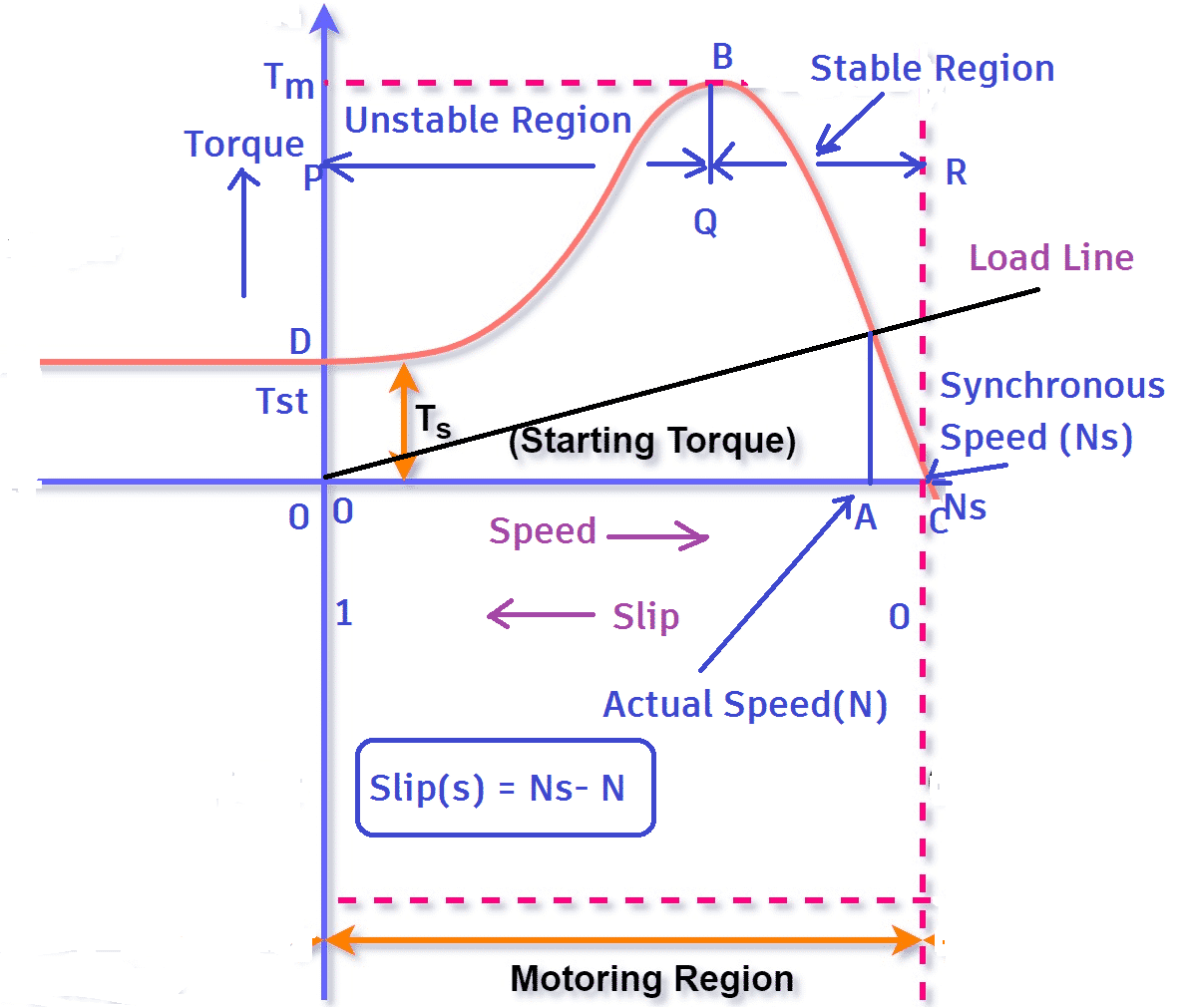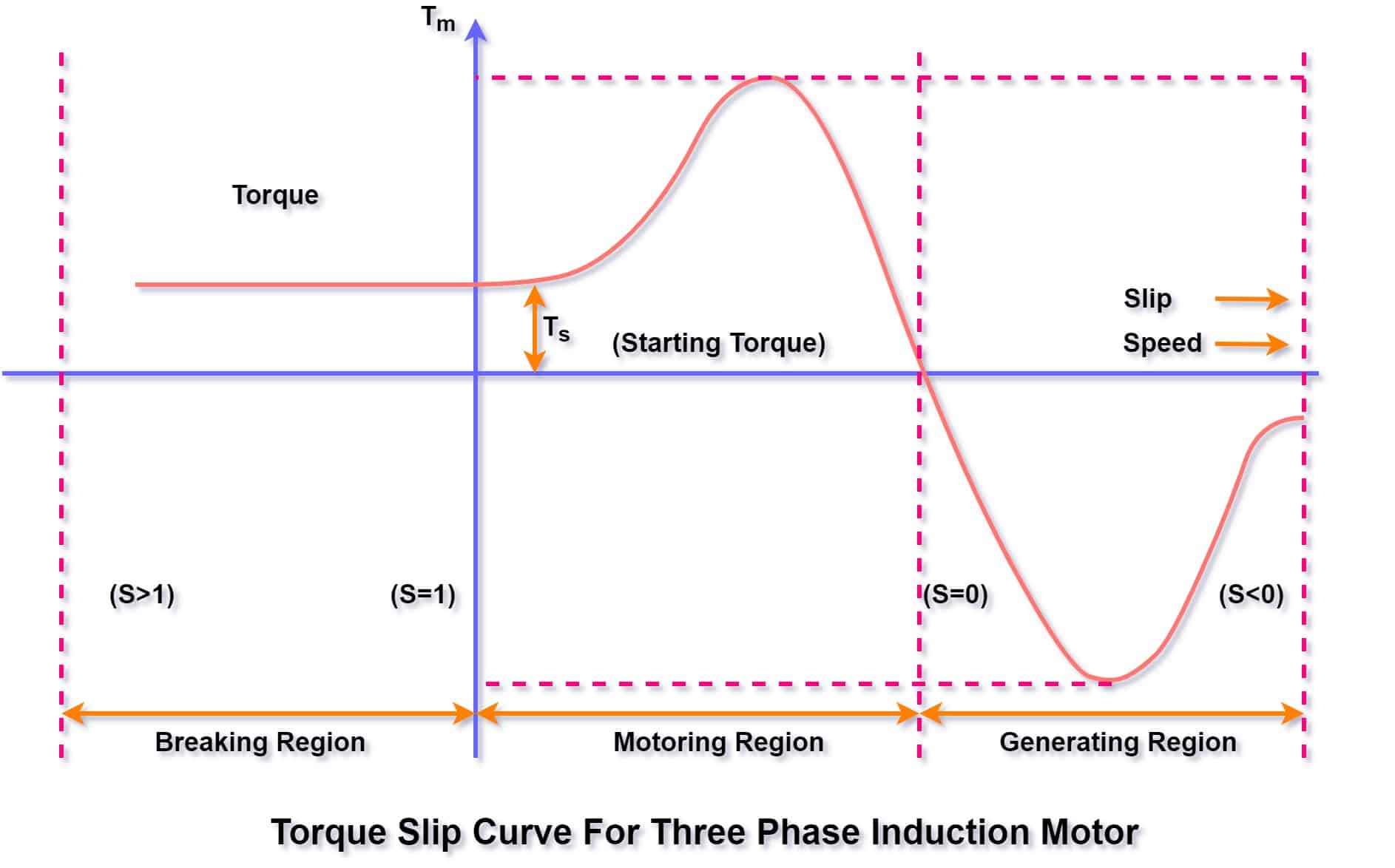Torque slip characteristics of induction motor show detailed information about torque and slip. There are three operating zones of induction motor. We shall discuss these operation zones in detail. The speed of the induction motor is characterized by the term known as the slip. The slip is defined as the ratio of the difference between synchronous speed and actual rotor speed to the synchronous speed of the machine.
The slip of the motor is expressed with the following formula.
s= (Ns-Nr)/Ns
Percentage slip=( Ns-Nr)/Ns x100
Where,
Ns = 120f/P – Synchronous speed,
Nr- The actual speed of the motor
The motor stable operating region is given below.

In the region from D to B, the motor produces pull-up torque to accelerate the load. This region (PQ) is the unstable zone of operation. If the load torque line falls in this zone, the motor will not be capable of driving the load, and the motor will get stalled. If the load torque line falls beyond point B (negative slope line), the motor will get its stable point of operation. QR region is the stable zone of operation.
The slip or the speed of the induction motor can be changed with the following methods.
- Adding external resistance in series with the rotor winding
- Adding external resistance in the series with the stator winding
- Reducing stator voltage by autotransformer
Operating Zones of Induction Motor & Torque Slip Characteristics
The torque of the motor also changes with the change in the slip. The speed-torque characteristics of the motor depict the lucid explanation of motor performance for a particular load. The induction motor can be operated into the three zones of operation by controlling the slip of the motor. The three zones of operation of the induction motor are given below.
1. Motoring Zone
2. Generating Zone
3. Braking Zone
The speed-torque characteristics of the induction motor under different zones are as given below.

Torque Slip Characteristics Of Induction Motor in Motoring Mode
In motoring mode, the slip of the induction motor is between 1 and 0.01. The slip of the motor can’t be zero, if it is so the torque will not produce in the motor, and the rotation of the motor is not possible. When the rotor is at rest position, the slip is 1. The slip of the motor starts decreasing as the motor accelerates from its resting position to its rated base speed.
The starting torque of the motor is low because the rotor impedance is more inductive because of higher slip and higher rotor frequency. With an acceleration of the motor, the induced voltage in the rotor and the slip of the motor decrease, and as a result, the torque-delivering capacity of the motor improves. When the motor torque meets the load torque point on the speed-torque curve, the motor stable point is achieved.
In the motoring mode of the operation, both speed and torque are positive. It is very important to study the moment of inertia (GD2) of the load before selecting the motor. The speed-torque curve of the driven equipment should be submitted to the motor manufacturer to meet the motor speed-torque characteristics with the driven equipment speed-torque characteristics.
Torque Slip Characteristics Of Induction Motor in Generating Mode
In this mode of operation, the induction motor runs above the synchronous speed of the motor. This condition happens when the rotor of the motor is connected to a prime mover and runs above the synchronous speed of the motor. The motor works as an induction generator. The other condition of the motor operating in generating mode is when the speed of the motor is reduced by reducing the frequency but the actual speed of the motor does not reduce with the change in the supply frequency. This phenomenon happens when the motor is driving high inertia loads. Both the slip & torque of the motor are negative in generating mode.
Slip Torque Characteristics in Braking Mode
In the braking mode of operation, the slip of the motor is more than unity. If the actual speed of the motor is more than the synchronous speed of the motor, the motor works as a generator. If the rotating kinetic energy of the motor is dissipated as heat, the braking torque is produced, and this braking torque will bring the motor speed down.
The various braking methods used for induction motors are as follows.
- Dynamic Braking
- DC injection braking
- Regenerative braking
- Plugging